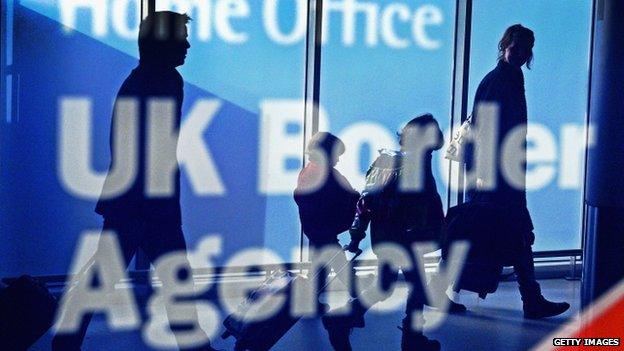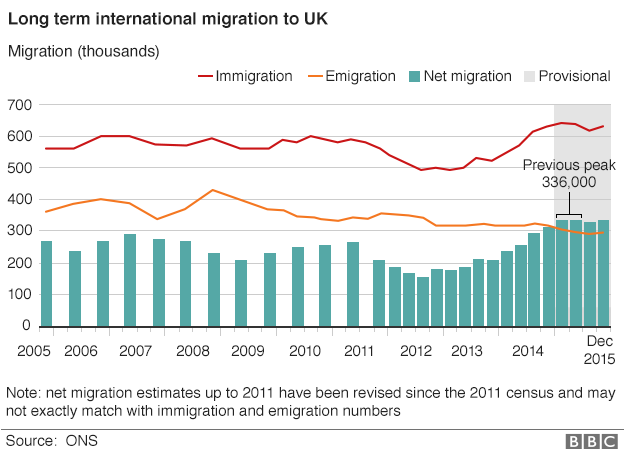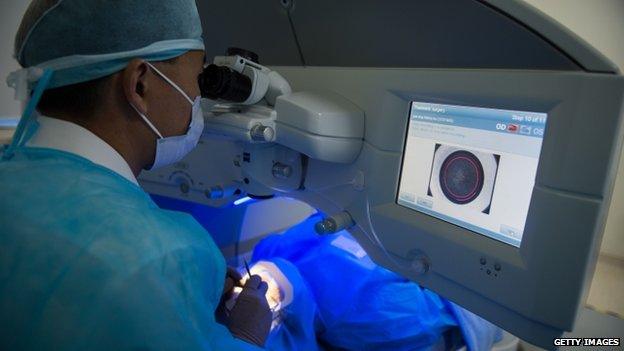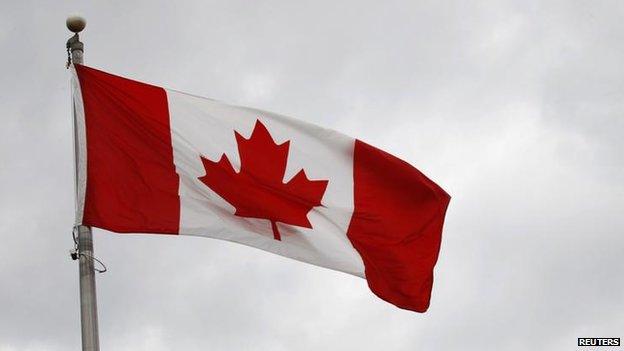Immigration points-based systems compared
- Published

The campaign to get Britain out of the EU has called for an Australian-style, points-based immigration system to be applied to all migrant workers - not just those from outside the EU. So how does the UK's system - also based on points - differ from those of other countries?

United Kingdom

The numbers
In the year to December 2015, an estimated total of 630,000 immigrants arrived in the UK to stay for more than a year, including 83,000 British citizens and 270,000 from other parts of the EU.
An estimated 297,000 emigrated from the UK, including 123,000 British citizens and 65,000 citizens of other EU countries.
The Office for National Statistics does not release a bulletin setting out the country of origin of immigrants, only the region they came from.
Separate figures for National Insurance numbers issued to foreign nationals for the year ending March 2016 show how many people registered to work in the UK.
The top five countries were:
Romania
Poland
Italy
Spain
Bulgaria
The top five countries for entry visas issued to non-EU nationals in the same year were:
China
India
United States
Australia
Pakistan

The UK's points-based system
In February 2008, the Labour government introduced, external the UK's first points-based immigration system heralded by ministers as being based on the Australian system. It replaced a labyrinthine scheme which saw 80 different types of visa granted.

The system contains a lengthy list of sub-tiers of migrant, but broadly they are classed as one of four 'tiers'. Tier 3 was intended to be a pathway for unskilled immigrants, but after the system began operating the British government decided there was no need for further unskilled immigration from outside the EU. Under the coalition, it has been removed and others tweaked so now the tiers are:
Tier 1: high-value (possessed of exceptional talent, highly skilled, high-net-worth investor, graduate entrepreneur)
Tier 2: skilled workers (jobs that cannot be fulfilled by a UK or EEA worker, intra-company transfers, ministers of religion or sportspersons) - capped at 20,700 a year unless the immigrant earns more than £150,000
Tier 4: student (in primary, secondary, or tertiary education)
Tier 5: temporary migrants
Each tier offers its own allocation of points for specific 'attributes'. For each of the groups in tier 1, a person earns points according to different criteria:
English language ability
Capacity to support oneself financially
Age and previous experience
The admission of migrants who possess "exceptional talent"- that is, who are acknowledged to be world leaders in their fields - is capped at 1,000 per year, although few have taken advantage of this route so far.
You must have a specific job offer in order to apply for entry under tier 2, and reach a total of 70 points.
By far the easiest means of meeting that target is by having a job on the 'Shortage Occupation List', such as chief executive officer of a major company, biochemist, engineer or medical practitioner. Such an occupation earns a person 50 points, to be topped up by other factors including age and experience.
Beyond the points
Because the UK is a member of the European Union the points-based system only applies to people who are moving to the UK from outside the European Union. There is freedom of movement across the EU and, barring temporary restrictions for some new member states, freedom to work as well.

Migrant health

Those with high skilled jobs, like surgeons, are unlikely to encounter much difficulty getting a UK visa
Paragraph 36 of the immigration rules provides that anyone planning to stay in the UK longer than six months should be referred for a medical examination, the cost of which is borne by the applicant. This is designed to ensure that no-one is admitted to the UK who might:
endanger the health of other persons in the UK
be unable for medical reasons to support themselves or their dependants in the UK
require major medical treatment (unless explicitly granted)
UK Visas and Immigration currently runs a tuberculosis-testing programme for aspiring immigrants in "high-incident countries, external" and their applications are paused, pending treatment, if they test positive.
Education
Immigrants from outside the EU wishing to pursue higher education in the UK must satisfy several criteria. They must:
Have been offered a place on a full time course leading to a recognised degree-level qualification
Be able speak, read, write and understand English
Have enough money to support themselves and pay for their course

Australia

Australia's immigration policy is a hot-button issue in every election
The numbers
Australia operates two immigration schemes: the Migration Programme, which caters for economic immigrants, and the Humanitarian Programme for refugees and displaced persons.
For the year 2013-14 Australia capped non-humanitarian immigrants at 190,000 - including the dependants of skilled workers. In that period Australia also welcomed approximately 20,000 people under its Humanitarian programme.
The latest figures for people leaving Australia - for 2012-13 - was 91,000.
The top 5 countries of origin for immigrants to Australia were:
India
China
United Kingdom
Philippines
Pakistan

The points-based system
The Australian Labor government elected in 1972 decided migrants would be granted a visa based on their personal attributes and ability to contribute to Australian society - most obviously, through their occupational status.
The previous policy, which selected migrants largely on a racial and ethnic basis, was discarded.
The points system - formalised in 1989 - has gone through several versions, and was most recently updated in July 2011. The Migration Programme divides available visas into two broad classes: skilled worker and employer-sponsored.
Skilled-worker visas are points-tested, and to be eligible for one a person must meet a 65-point minimum. Skilled workers include professional and manual workers, with accountants and mechanics alike earning 60 points for their occupation. Those on the lower end of the scale, at 40 points, include youth workers and interior decorators.
For people in a job on the skilled-worker list, points are awarded for factors including age, recognised qualifications, and previous experience working abroad.
Those on employee-sponsored visas are not points-tested.

Migrant health:
Australia also has a health requirement for immigrants, designed to:
minimise public health and safety risks to the Australian community;
contain public expenditure on health and community services, including Australian social security benefits, allowances and pensions; and
maintain the access of Australian residents to health and community services.
Everyone applying for a permanent visa needs to complete a medical check, a chest x-ray (if older than 11) and HIV test (if older than 15).
Only tuberculosis specifically precludes an applicant from meeting the health requirement, though even then they may resume their application after treatment.
Those with other conditions are assessed by visa officers on the cost and impact of their treatment in Australian society, before a decision is made.
Character test
Australia has a mandatory "character test" for immigrants, designed to exclude anyone with a "substantial criminal record" or who is deemed to be a risk to the community.
If someone is thought at risk of the following then they are excluded:
engage in criminal conduct
harass, molest, intimidate or stalk another person
vilify a segment of the Australian community
incite discord in the Australian community or in a part of it
be a danger to the Australian community or a part of it
you have been convicted, found guilty or had a charge proven for, one or more sexually based offences involving a child
you are subject to an adverse security assessment by the Australian Security Intelligence Organisation
you are subject to an Interpol notice, from which it is reasonable to infer that you are a direct or indirect risk to the Australian community, or a segment of the Australian community.

Canada

Canada currently takes in over 250,000 immigrants a year
The numbers
In 2013, Canada welcomed 258,619 immigrants, including economic migrants and refugees
The latest figures indicate that in the same period, approximately 65,000 people left Canada.
The top 5 countries of origin for immigrants to Canada were:
Philippines
China
India
United States
Iran

Points-based system
Canada was the first country to introduce a points-based system, in 1967. According to a report by the think-tank CentreForum, external, the Canadian system's distinguishing feature is that it "prioritises broadly desirable human capital, rather than a specific job offer".
Like other countries, Canada distinguishes between skilled workers and other kinds of immigrant.
Those applying for a federal skilled worker visa without a job offer are capped at 25,500, plus 1,000 each for a number of professional and technical professions.
Some migrants can receive greater weighting for going to a particular territory, such as Nova Scotia.
To qualify for Canadian immigration, a person has to meet a minimum of 67 points, with the maximum for each area as follows: 25 points from their educational background, 24 points from proficiency in the English and French languages, 21 points for previous work experience, 10 points for being in the prime age of employment, and up to 10 if one has an offer of employment. Financial background is also taken into consideration.

Migrant health
Immigrants to Canada must undergo medical examination by one of a list of physicians in their country of origin approved by the Canadian government. There are no diseases whose possession would immediately halt an application to immigrate - all cases are assessed individually.
Medical inadmissibility is likely to be declared for applicants whose condition:
is a danger to public health or safety, or
would cause excessive demand on the Canadian healthcare or social services systems
Education
Canada offers a student visa to any applicant who has:
been accepted by an institution of higher education
enough money to pay for tuition fees, living expenses, and return transportation from Canada
no criminal record
a bill of clean health, with a medical exam if necessary
a definite plan to leave after the course of study
